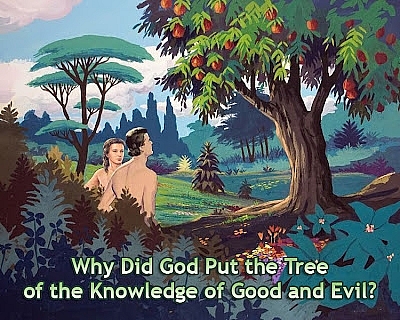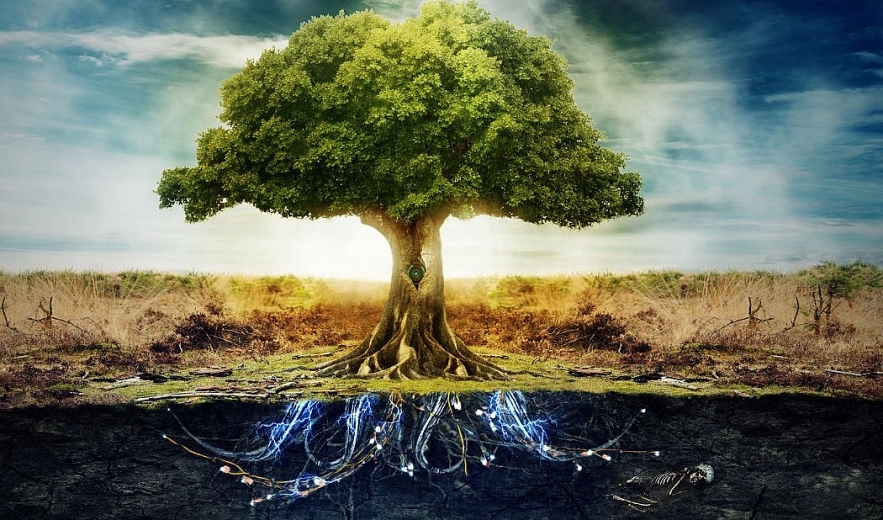Tree of the Knowledge of Good and Evil: Symbolism, Meaning and Unique Facts
| Table of Contents |
 |
| The Tree of the Knowledge of Good and Evil |
What was the Tree of Knowledge of Good and Evil?
1.The Tree of Knowledge of Good and Evil was one of the many trees that God made spring up out of the ground in the Garden of Eden. But unlike most of the others, this specific tree, along with the Tree of Life, was a very unique one.
God planted many trees in the Garden of Eden. The world’s climate and atmosphere would’ve felt very different pre-Flood, so we don’t know the precise nature of these trees. But we do know they likely were of a Middle Eastern type, as that is where most theologians have placed the location of the Garden of Eden.
In that big beautiful garden, Adam and Eve could eat from whatever tree they wished, except for the Tree of Knowledge of Good and Evil. God specifically instructed them that that tree was not allowed and that if they would eat from it, death would come to them.
Although God allows for Adam and Eve to partake in the fruit of any tree in the Garden of Eden, he forbids them from eating of the tree of the knowledge of good and evil. He gives this with a warning that they will die if they do so. Supposedly, the tree could give them the knowledge of good and evil, but doing so would come at a cost.
Another tree in the Garden was the tree of life (Genesis 2). Adam and Eve, as long as they lived in the Garden, had access to its life-giving fruit. But once they ate of the forbidden tree, they had to leave this place of paradise.
2.The knowledge of good and evil is literal and straightforward. Although many know what may be “good” for humans, “evil” is a very specific word tied to morality, and in this case, a morality linked to a spiritual realm and an almighty supreme being. “Evil,” when compared to words such as “bad” or “unhealthy,” conjures a higher level of judgment: a judgment from God. When a thing, act, or individual is called “evil,” it accuses that subject to a metaphysical condemnation presumably authorized by God himself. This labelling of “evil” would cause much fear for people with strong religious beliefs. Whether this concept of evil is sanctioned by God or not, the power to categorize good and evil would create an authority that could rule over a community with a shared belief system in such a moral code. This has little difference to our current 21st century legal system: certain actions such as murder and stealing are labelled unlawful.
Today, however, many justice systems steer away from calling things “evil” as such verbiage can tie in religious beliefs that most democracies, with a separation of church and state, try to avoid as it can cause much conflict and tension in what should be a free and open society where individuals can choose what they want to believe.
Summary
The tree of the knowledge of good and evil was placed by God in the midst of the garden to provide a test for man. We can make the following conclusions.
-For humans to be fully human there had to be a legitimate test to see which way they would choose.
-It was the only negative commandment that God gave to Adam and Eve.
-There was nothing intrinsically sinful about the tree or the fruit. The sin was in disobeying God.
-The idea that God tests His creation is found consistently throughout Scripture.
-There will be no similar tree in the future because evil will no longer exist.
What Does This Tree Represent: Moral Maturity?
What does the tree of knowledge symbolize in the Garden of Eden?
Perhaps the tree of knowledge represented the law (which brings death, 2 Corinthians 3:6) and the tree of life represented a right relationship with God. Adam and Eve, when they disobeyed and ate the fruit, decided they’d rather abide by the rules than by a relationship, according to the Christianity.com article.
Other theologians have posited it had knowledge that only God was meant to possess. Christians have also devised many erroneous conclusions as to the types of knowledge that Adam and Eve received in the Garden.
Suffice to say, we don’t know the precise nature of the knowledge they received. But we do know that this tree also later represents the fall of man. The tree itself wasn’t evil. But because God had given explicit instructions not to eat of its fruit, and Adam and Eve disobeyed, sin polluted both them and the tree. The ground, human nature, everything ends up cursed because of what happens in Genesis 3.
Solomon’s request comes alongside his confession that he is like “a little child” (v. 7), and this points us to the second aspect of “the knowledge of good and evil.” It is associated with maturity—the type of maturity that is required to be a position of issuing moral judgments. To lack it is to be immature, or like a child. This is what God said of the children of the wilderness generation, before their entrance into Canaan:
Moreover, your little ones who you said would become a prey, and your sons, who this day have no knowledge of good or evil, shall enter there, and I will give it to them and they shall possess it (Deuteronomy 1:39).
To lack this knowledge is not morally blameworthy in an immature child; it is simply natural. At the same time, for those who should be further along in wisdom, knowledge of good and evil is expected. Listen to the author of Hebrews’ rebuke to his readers:
For though by this time you ought to be teachers, you have need again for someone to teach you the elementary principles of the oracles of God, and you have come to need milk and not solid food. For everyone who partakes only of milk is not accustomed to the word of righteousness, for he is an infant. But solid food is for the mature, who because of practice have their senses trained to discern good and evil (Hebrews 5:12-14).
Bringing this back to the tree in the garden, we can say that the name “the knowledge of good and evil” did not signify that this was a magic tree that one could eat from and have informational knowledge automatically implanted.
The fruit of the tree was to be food for Adam along with the rest of the trees if he were to grow in wisdom and maturity and demonstrate the capacity to truly discern and judge between good and evil. The tree was the testing point, to see if and in what way Adam would become one who “knows good and evil.”
What Did The Tree Mean?
Concretely, the tree represented for Adam the choice between submitting to God’s law or pursuing moral autonomy: Fearing the Lord (the beginning of wisdom), or judging for himself what good and evil are. Learning obedience would result in greater wisdom, maturity, and freedom. That is what the serpent tempted Adam and Eve with: “You shall be as gods, knowing good and evil” (Genesis 3:5). That is, you shall judge for yourselves. You will no be in the position of children, having good and evil dictated to you. The serpent tempted Adam and Eve with the prerogatives of autonomous, mature adulthood, before they had learned submission to God—and he tempted them to achieve this by way of disobedience. But it is important to understand that it could have been achieved with obedience as well, without the consequences of sin—and that is the tragedy. Adam and Eve were indeed destined to rule creation. Becoming like gods was not a bad thing or a bad desire. But this was to be achieved in the same way the rule of Jesus was achieved—by submission to God (Philippians 2:8-9).
Note also, “good and evil” here is probably a broader category than just morality. The immediate antecedent is God’s judgment over his creation in Genesis 1: “God saw that it was good.” This is not a question of the moral uprightness of the moon and plants and fishes. It is “good” in the sense of “fitting” or “beautiful.” The tree, as the testing point of Adam’s obedience, would also be the opportunity for him to exercise his judgment with regard to what is proper and fitting. One thing that was very unfitting in Adam’s action was that he allowed himself to be drawn away and made subservient to the serpent, a “beast of the field” (Genesis 3:1), a creature that God had given Adam and Eve a commission to exercise dominion over.
So an immediate effect of Adam and Eve’s sin was that their eyes were opened, and they saw that they were naked. Having acted out of accord with truth, goodness, and beauty by stepping outside of God’s command and seeking autonomy for themselves, all the while submitting to a creature who they should ruler over, they recognized their exposure and vulnerability, and their lack of glory. Clothing in the Bible represents glory, and Adam and Eve realized that in their immaturity they had reached for a godlikeness that they were not ready for, because they had not learned obedience. Adam and Eve were like little kids who want mommy and daddy’s tools and devices, and upon getting them, realize they do not know what to do with them and simply end up hurting themselves.
Paul says, “The heir, as long as he is a child, is no different from a slave, though he is owner of everything, but he is under guardians and stewards until the date set by his father” (Galatians 4:1-2). This was Adam and Eve’s position exactly. They were children, in the position of servants, having not yet entered the promised inheritance. They first needed the schoolmaster of the law. Their obedience to God would have issued in greater freedom and greater glory, and being trained in righteousness, righteousness and not sin is what they would have used their freedom to pursue (cf. Galatians 5:13). They would have understood that submission to God’s rule is good and fitting—and thus humbling themselves, they would have been exalted.
Having stepped out and grasped at this glory however, they did achieve a kind of maturity of experience, and so God acknowledges that “the man has become like one of us, knowing good and evil” (Genesis 3:22), though it was in a tragic manner. He also clothes them in recognition of this.
The Purpose of the Tree
The tree of the knowledge of good and evil, referred to in the question as the “forbidden tree,” was placed in the garden of Eden, most likely on the sixth day. Its purpose appears to have been twofold.
The first and most often considered purpose was to provide man with a choice: to love and serve God willingly or to rebel against him and reject the one prohibition he had given them. The second purpose is less clear, but Genesis 2:9 points to a possible option.
This verse describes all trees as being either pleasant to look at or good for food. While the fruit of the tree of the knowledge of good and evil was certainly not good for Adam and Eve to eat (because it would bring death), there is no indication that animals could not have eaten it. This is a small but significant detail. With this second purpose in mind, the popular view of the “forbidden tree” changes. It could have been described as good simply because it had a purpose.
Read More: Good Friday in the Bible: Definition, History, Meaning, Traditions and Facts
Why Did God Create the Tree of Knowledge?
If he didn’t want them to get tempted in the first place, he should’ve removed all chances of temptation.” But we have to understand the necessity of the tree and why he had to place it in the Garden.
God is a God of love. It comprises his entire being. And if he wanted to give humans free will, something a loving God would do, he had to allow for the possibility for them to choose something over him, and therefore, sin.
If someone creates a robot and programs the machine to do a certain number of functions, we wouldn’t say the robot is capable of free will or love. Free will and love come with a cost. We learn the cost in Scripture. Because mankind chose to use free will incorrectly, Jesus had to die on the cross.
| Moral Test God had made humanity in His image and after His likeness. Humankind was like God in the sense that he could love, think, and communicate. There was now a test that was going to be made. Human beings would not be truly human unless there was some test to determine their faithfulness to God. God, therefore, set apart one tree from all the other trees and forbade humankind to eat of that tree. Actual Tree As was true with the tree of life, the tree of the knowledge of good and evil was an actual tree. The tree of the knowledge of good and evil would have had to have been unique-there would have been no chance the fruit would have been eaten by mistake. Nature Of The Tree There was nothing intrinsically evil about the tree that God forbade humanity to eat. It is not necessary to assume, as some have done, that God created a special type of tree. He may have designated one specific tree as the forbidden one. Furthermore, we do not know what type of fruit it was that Adam and Eve were forbidden to eat. Western tradition has suggested it was an apple, but rabbinical literature suggest either the grape or the apricot. Others believe it was a vine rather than a tree. The only fruit mentioned in the passage is the fig tree (verse 7). The idea that it was an apple may have originated from the common sound in Latin for apple malum and evil malus. It has been suggested that some type of poison was introduced into humankind's system from the eating of the tree. However, it is not necessary to assume that the tree contained some poison that would eventually result in their death. Nature Of God The point of the test is that God told them not to eat of a certain tree. The sin was disobeying God, there was no magical power in the fruit. God Himself is the ultimate source of what is right and what is wrong. If He said it was wrong to eat of that tree, then it was wrong. The Bible makes it clear that God is responsible to no one. God's Testing Of Humanity The Bible says that the tree of the knowledge of good and evil was placed within the reach of Adam. Why do such a thing? This introduces us to one of the consistent themes of Scripture - God tests His people. God wishes to see how we react to Him and His commandments. God's testing is to bring out the best in us, not the worst. Did Evil Already Exist? This brings us to another issue. Some commentators feel that evil would already have had to exist for God to make this commandment. They argue that the idea of evil would have made no sense to Adam unless he had somehow previously observed it. Others disagree. They do not feel that Adam had to completely comprehend the concept of evil when God made him aware of its possible entrance into the world. Scripture Does Not Clearly Say Scripture does not clearly tell us either way whether Adam had any concept of evil when God gave him the commandment not to eat of the fruit of the tree. Consequently, there is no way to be certain as to Adam's understanding of sin before the Fall. No Evil Tree In Future Though there will be a tree of life in the world to come, there will not be a counterpart of the tree of the knowledge of good and evil. In the future world, there will be no moral test necessary. The victory over evil has been won, not by Adam, but by Christ. |
Why did God put the tree of knowledge of good and evil in the Garden of Eden?
 |
| Tree of knowledge of good and evil in the Garden of Eden |
God put the tree of knowledge of good and evil in the Garden of Eden to give Adam and Eve a choice to obey Him or disobey Him. Adam and Eve were free to do anything they wanted, except eat from the tree of knowledge of good and evil. Genesis 2:16-17, “And the LORD God commanded the man, ‘You are free to eat from any tree in the garden; but you must not eat from the tree of the knowledge of good and evil, for when you eat of it you will surely die.’” If God had not given Adam and Eve the choice, they would have essentially been robots, simply doing what they were programmed to do. God created Adam and Eve to be “free” beings, able to make decisions, able to choose between good and evil. In order for Adam and Eve to truly be free, they had to have a choice.
There was nothing essentially evil about the tree or the fruit of the tree. It is unlikely that the fruit, in and of itself, gave Adam and Eve any further knowledge. That is, the physical fruit may have contained some vitamin C and some beneficial fiber, but it was not spiritually nutritious. However, the act of disobedience was spiritually deleterious. That sin opened Adam’s and Eve’s eyes to evil. For the first time, they knew what it was to be evil, to feel shame, and to want to hide from God. Their sin of disobeying God brought corruption into their lives and into the world. Eating the fruit, as an act of disobedience against God, was what gave Adam and Eve the knowledge of evil—and the knowledge of their nakedness (Genesis 3:6–7).
God did not want Adam and Eve to sin. God knew ahead of time what the results of sin would be. God knew that Adam and Eve would sin and would thereby bring evil, suffering, and death into the world. Why, then, did God allow Satan to tempt Adam and Eve? God allowed Satan to tempt Adam and Eve to force them to make the choice. Adam and Eve chose, of their own free will, to disobey God and eat the forbidden fruit. The results—evil, sin, suffering, sickness, and death—have plagued the world ever since. Adam and Eve’s decision results in every person being born with a sin nature, a tendency to sin. Adam and Eve’s decision is what ultimately required Jesus Christ to die on the cross and shed His blood on our behalf.
Through faith in Christ, we can be free from sin’s consequences, and ultimately free from sin itself. May we echo the words of the Apostle Paul in Romans 7:24-25, “What a wretched man I am! Who will rescue me from this body of death? Thanks be to God—through Jesus Christ our Lord!”
How Old Is The Earth In Science, Bible
What happened to the tree of knowledge?
After all, the tree of life does make another appearance in Revelation 2 and Revelation 22:2. Does the tree of knowledge show up anywhere else in the Bible or in history?
After the fall (Genesis 3), Adam and Eve are disbanded from the Garden of Eden, never to enter again. Considering the tree of knowledge was in the middle of the Garden, and since trees don’t have a tendency to walk apart from Tolkien stories, we can assume it stayed put.
Symbolically the tree of knowledge lives on in the hearts of every man. We choose, every one of us, to place something else in the throne of our lives instead of Jesus. Thankfully, because of Jesus’ sacrifice, we can come back to the relationship with God and experience the tree of life.
Unique Facts about the Tree of Knowledge
 |
| Facts about the Tree of Knowledge |
1.It likely had figs for the fruit (although some theologians have surmised it was wheat).
This makes sense given the Garden of Eden existed in the Middle East. Perhaps this also plays into the reason as to why Jesus curses a fig tree in Mark 11. Because of the tree’s ties to the infamous tree from back in the Garden. This also explains why Adam and Eve sewed together fig leaves to hide their nakedness after they sinned. Although others have suggested that perhaps they ate an apricot or grape. Most likely, it wasn’t an apple.
2. Among all the trees in the Garden of Eden, God identified two special trees: of life, and of the knowledge of good and evil.
“And out of the ground the LORD God made to spring up every tree that is pleasant to the sight and good for food. The tree of life was in the midst of the garden, and the tree of the knowledge of good and evil.” (Genesis 2:9)
3.God allowed Adam to eat from all the trees except the tree of the knowledge of good and evil, warning him that death would result.
“The LORD God commanded the man, saying, ‘You may surely eat of every tree of the garden, but of the tree of the knowledge of good and evil you shall not eat, for in the day that you eat of it you shall surely die.'” (Genesis 2:16-17)
4.After being tempted by the serpent, Eve ate from the tree of the knowledge of good and evil and Adam did the same.
“So when the woman saw that the tree was good for food, and that it was a delight to the eyes, and that the tree was to be desired to make one wise, she took of its fruit and ate, and she also gave some to her husband who was with her, and he ate.” (Genesis 3:6)
“Then the eyes of both were opened, and they knew that they were naked. And they sewed fig leaves together and made themselves loincloths.” (Genesis 3:7)
5.The tree was more likely a test of faithfulness, and Adam and Eve could’ve acquired the knowledge of good and evil without it.
As mentioned in the Crosswalk article linked in the former paragraph, God likely wanted Adam and Eve to exercise faith and obedience. Through their relationship with him, they could’ve learned about good and evil. Rather than acquire that knowledge from a third party.
6.After eating from the tree of the knowledge of good and evil—in part to become “wise”—Adam now possesses the knowledge of good and evil like God does, as well as knowledge of their nakedness.
“. . . the woman saw that the tree . . . was to be desired to make one wise.” (Genesis 3:6)
“Then the eyes of both were opened, and they knew that they were naked. And they sewed fig leaves together and made themselves loincloths.” (Genesis 3:7)
“Then the LORD God said, ‘Behold, the man has become like one of us in knowing good and evil.'” (Genesis 3:22b-24)
7.After Adam disobeyed God’s command regarding the tree of the knowledge of good and evil, God forbade Adam to eat from the tree of life lest he live forever in that state; therefore God guards the tree.
“Then the Lord God said, ‘. . . Now, lest [the man] reach out his hand and take also of the tree of life and eat, and live forever—” therefore the Lord God sent him out from the garden of Eden to work the ground from which he was taken. He drove out the man, and at the east of the garden of Eden he placed the cherubim and a flaming sword that turned every way to guard the way to the tree of life.” (Genesis 3:22b-24)
8.As mentioned above the tree of life represents a rightful relationship with God and the tree of knowledge symbolizes the death that comes through the law.
Every human being, ever since the Garden of Eden, intuitively knows about God (Romans 1:20). Many of us have also received specific revelation through Scripture or other means. Because of this knowledge, we have no excuse when we stand in the presence of God and have to explain our deeds on Earth.
Praise the Lord, however, that we have a Savior who sacrificed himself for us so that we may live. Even though we all, as humanity, partook of the tree of knowledge, we have an opportunity to return to a relationship with the Lord and experience the tree of life.
The Tree of the Knowledge: Evil or Good?
While the tree of the knowledge of good and evil served as the opportunity for man to disobey, it was not wicked on its own. God could rightly have looked at his creation after day six, after making that tree, and called it “very good” (Genesis 1:31). There was no intrinsic evil in it, so there could not have been wickedness in the “forbidden tree.” The wickedness would be introduced later, but not by the tree. Instead it would be introduced by Adam and Eve’s choice to rebel against God’s command, which caused death and Adam’s sin nature to pass on to all of his descendants (Romans 5:12). In short, the answer to the commenter’s question is, yes, the tree of the knowledge of good and evil was good. The fault for man’s fall lies with Adam and Eve, not the tree.
God laid a temporary prohibition on his children, who were set to grow into wise, mature, and free adulthood by way of obedience. They were to become like gods, judging between good and evil, and the tree was an opportunity to train them in this. However, the serpent tempted them with seizing this prerogative prematurely, by way of rebellion. Adam and Eve did judge between good and evil, but their act of judgment was flawed and proved fatal.
| And out of the ground the Lord God made to spring up every tree that is pleasant to the sight and good for food. The tree of life was in the midst of the garden, and the tree of the knowledge of good and evil (Genesis 2:9).1 And the Lord God commanded the man, saying, Of every tree of the garden thou mayest freely eat: But of the tree of the knowledge of good and evil, thou shalt not eat of it: for in the day that thou eatest thereof thou shalt surely die (Genesis 2:16–17). And God saw every thing that he had made, and, behold, it was very good. And the evening and the morning were the sixth day (Genesis 1:31). |
























